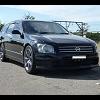P0340 RB25DET ER34 Skyline - Car Wouldn't Start
Announcements
-
Similar Content
-
Latest Posts
-
Embrace the freedom of casual encounters on the best dating app in town! Verified Maidens Superlative Сasual Dating
-
Slimline sub on the rear parcel shelf is doable. Pioneer TS-WX140DA is only 70mm high.
-
People like Johnny Dose Bro might be laughing at my post because I accidentally added 100mm to my numbers. 350-355 is indeed the lower limit. 450 is off-road Skyline spec.
-
What is the "compromise" that you think will happen? Are you thinking that something will get damaged? The only things you have to be concerned about with spherical jointed suspension arms are; Arguments with the constabulary wrt their legality (they are likely to be illegal for road use without an engineering certificatation, and that may not be possible to obtain). A lot more NVH transmitted through to the passengers (which is hardly a concern for those with a preference for good handling, anyway). Greatly increased inspection and maintenance requirements (see above points, both). It is extremely necessary to ask what car you are talking about. Your discussion on strut tops, for example, would be completely wrong for an R chassis, but be correct for an S chassis. R32s have specific problems that R33/4 do not have. Etc. I have hardened rubber bushes on upper rear control arms and traction rods. Adjustable length so as to be able to set both camber and bump steer. You cannot contemplate doing just the control arms and not the traction arms. And whatever bushing you have in one you should have in the other so that they have similar characteristics. Otherwise you can get increased oddness of behaviour as one bushing flexes and the other doesn't, changing the alignment between them. I have stock lower rear arms with urethane bushes. I may make changes here, these are are driven by the R32's geometry problems, so I won't discuss them here unless it proves necessary. I have spherical joints in the front caster rods. I have experienced absolutely no negatives and only positives from doing so. They are massively better than any other option. I have sphericals in the FUCAs, but this is driven largely by the (again) R32 specific problems with the motion of those arms. I just have to deal with the increased maintenance required. Given how much better the front end behaves with the sphericals in there.....I'd probably be tempted to go away from my preference (which is not to have sphericals on a road car, for 2 of the 3 reasons in the bulleted list above), just to gain those improvements. And so my preference for not using sphericals (in general) on a road car should be obvious. I use them judiciously, though, as required to solve particular problems.
-
By joshuaho96 · Posted
Easiest way to know is to break out the multimeter and measure it when cold, then measure all the resistances again once it gets hot enough to misfire. Both the original ignitor and the J Replace version. Factory service manual will have the spec for the terminal measurements.
-




Recommended Posts
Create an account or sign in to comment
You need to be a member in order to leave a comment
Create an account
Sign up for a new account in our community. It's easy!
Register a new accountSign in
Already have an account? Sign in here.
Sign In Now